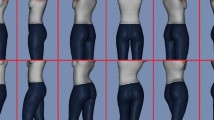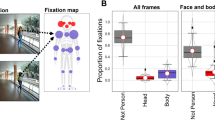Abstract
Eye-tracking techniques were used to measure men’s attention to back-posed and front-posed images of women varying in waist-to-hip ratio (WHR). Irrespective of body pose, men rated images with a 0.7 WHR as most attractive. For back-posed images, initial visual fixations (occurring within 200 milliseconds of commencement of the eye-tracking session) most frequently involved the midriff. Numbers of fixations and dwell times throughout each of the five-second viewing sessions were greatest for the midriff and buttocks. By contrast, visual attention to front-posed images (first fixations, numbers of fixations, and dwell times) mainly involved the breasts, with attention shifting more to the midriff of images with a higher WHR. This report is the first to compare men’s eye-tracking responses to back-posed and front-posed images of the female body. Results show the importance of the female midriff and of WHR upon men’s attractiveness judgments, especially when viewing back-posed images.




Similar content being viewed by others
References
Björntorp, P. (1997). Body fat distribution, insulin resistance and metabolic disease. Nutrition, 13, 795–803.
Buss, D. M. (1989). Sex differences in human mate preferences: evolutionary hypotheses tested in 37 cultures. Behavior and Brain Sciences, 12, 1–49.
Buss, D. M. (2003). The evolution of desire (2nd ed.). New York: Basic Books.
Carter, L. E. J., & Heath, B. H. (1990). Somatotyping: Development and applications. Cambridge: Cambridge University Press.
Castellanos, E. H., Charboneau, E., Dietrich, M. S., Park, S., Bradley, P., Mogg, K., et al. (2009). Obese adults have visual attentional bias for food cue images: evidence for altered reward system function. International Journal of Obesity, 33, 1063–1073.
Clarys, J. P., Martin, A. D., & Drinkwater, D. T. (1984). Gross tissue weights in the human body by cadaver dissection. Human Biology, 56, 459–473.
Cornelissen, P. L., Hancock, P. J. B., Kiviniemi, V., George, H. R., & Tovée, M. J. (2009). Patterns of eye movements when male and female observers judge female attractiveness, body fat and waist-to-hip ratio. Evolution and Human Behavior, 30, 417–428.
De Martino, B., Kalisch, R., Rees, G., & Dolan, R. J. (2009). Enhanced processing of threat stimuli under limited attentional resources. Cerebral Cortex, 19, 127–134.
Dixson, B. J., Dixson, A. F., Li, B., & Anderson, M. J. (2007a). Studies of human physique and sexual attractiveness: sexual preferences of men and women in China. American Journal of Human Biology, 19, 88–95.
Dixson, B. J., Dixson, A. F., Morgan, B., & Anderson, M. J. (2007b). Human physique and sexual attractiveness: sexual preferences of men and women in Bakossiland, Cameroon. Archives of Sexual Behavior, 36, 369–375.
Dixson, B. J., Grimshaw, G, M., Linklater, W. L., & Dixson, A. F. (2009). Eye tracking of men’s preferences for waist-to-hip ratio and breast size of women. Archives of Sexual Behavior. doi:10.1007/s10508-009-9523-5.
Dixson, B. J., Dixson, A. F., Bishop, P., & Parish, A. (2010a). Human physique and sexual attractiveness in men and women: a New Zealand—U.S.A comparative study. Archives of Sexual Behavior, 39, 798–806.
Dixson, B. J., Li, B., & Dixson, A. F. (2010b). Female waist-to-hip ratio, body mass index and sexual attractiveness in China. Current Zoology, 56, 175–181.
Dixson, B. J., Sagata, K., Linklater, W. L., & Dixson, A. F. (2010c). Male preferences for waist to-hip ratio and body mass index in the highlands of Papua New Guinea. American Journal of Physical Anthropology, 141, 620–625.
Dufour, D. L., & Slather, M. L. (2002). Comparative and evolutionary dimensions of the energetics of human pregnancy and lactation. American Journal of Human Biology, 14, 584–602.
Fink, B., Matts, P. J., Klingenberg, H., Kuntze, S., Bettina, W., & Grammer, K. (2008). Visual attention to variation in facial skin color distribution. Journal of Cosmetic Dermatology, 7, 155–161.
Furnham, A., Tan, T., & McManus, C. (1997). Waist-to-hip ratio and preferences for body shape: a replication and extension. Personality and Individual Differences, 22, 540–549.
Grammer, K., Fink, B., Møller, A. P., & Thornhill, R. (2003). Darwinian aesthetics: sexual selection and the biology of beauty. Biological Reviews, 78, 385–407.
Henss, R. (2000). Waist-to-hip ratio and female attractiveness: evidence from photographic stimuli and methodological considerations. Personality and Individual Differences, 28, 501–513.
Hewig, J., Trippe, R. H., Hecht, H., Straube, T., & Miltner, W. H. R. (2008). Gender differences for specific body regions when looking at men and women. Journal of Nonverbal Behavior, 32, 67–78.
Jasienska, G., Ziomkiewicz, A., Ellison, P. T., Lipson, S. F., & Thune, I. (2004). Large breasts and narrow waists indicate high reproductive potential in women. Proceedings of the Royal Society of London. Series B, 271, 1213–1217.
Kirschner, M. A., & Samojlik, E. (1991). Sex hormone metabolism in upper and lower body obesity. International Journal of Obesity, 15, 101–108.
Langlois, J. H., Roggman, L. A., Casey, R. J., Ritter, J. M., Rieser-Danner, L. A., & Jenkins, V. Y. (1987). Infant preferences for attractive faces: rudiments of a stereotype? Developmental Psychology, 23, 363–369.
Lassek, W. D., & Gaulin, S. J. C. (2007). Menarche is related to fat distribution. American Journal of Physical Anthropology, 133, 1147–1151.
Lipson, S. F., & Ellison, P. T. (1996). Comparison of salivary steroid profiles in naturally occurring conception and non-conception cycles. Human Reproduction, 11, 2090–2096.
Lykins, A. D., Meana, M., & Kambe, G. (2006). Detection of differential viewing patterns to erotic and non-erotic stimuli using eye-tracking methodology. Archives of Sexual Behavior, 35, 569–575.
Lykins, A. D., Meana, M., & Strauss, G. P. (2008). Sex differences in visual attention to erotic and non-erotic visual stimuli. Archives of Sexual Behavior, 37, 219–228.
Maner, J. K., Gailliot, M. T., & DeWall, C. N. (2007). Adaptive attentional attunement: evidence for mating-related perceptual bias. Evolution and Human Behavior, 28, 28–36.
Maner, J. K., DeWall, C. N., & Gailliot, M. T. (2008). Selective attention to signs of success: social dominance and early stage interpersonal perception. Personality and Social Psychology Bulletin, 34, 488–501.
Marlowe, F., Apicella, C. L., & Reed, D. (2005). Men’s preferences for women’s profile waist-to-hip ratio in two societies. Evolution and Human Behavior, 25, 371–378.
Moran, C., Hernandez, E., Ruiz, I. E., Fonseca, M. E., Bermudez, J. A., & Zarate, A. (1999). Upper body obesity and hyperinsulinemia are associated with anovulation. Gynecologic and Obstetric Investigation, 47, 1–5.
Platek, S. M., & Singh, D. (2010). Optimal waist-to-hip ratios in women activate neural reward centers in men. PLoS ONE, 5, e9042. doi:10.1371/journal.pone.0009042.
Raymond, J. E., & O’Brien, L. (2009). Selective visual attention and motivation: the consequences of value learning in an attentional blink task. Psychological Science, 20, 981–988.
Rozmus-Wrzesinska, M., & Pawlowski, B. (2005). Men’s ratings of female attractiveness are influenced more by changes in female waist size compared with changes in hip size. Biological Psychology, 68, 299–308.
Rupp, H. A., & Wallen, K. (2007). Sex differences in viewing sexual stimuli: an eye tracking study of men and women. Hormones and Behavior, 51, 524–533.
Ruz, M., & Lupiáñez, J. (2002). A review of attentional capture: on its automaticity and sensitivity to endogenous control. Psicológica, 23, 283–309.
Shimojo, S., Simion, C., Shimojo, & Scheier, S. (2003). Gaze bias both reflects and influences preference. Nature Neuroscience, 6, 1317–1322.
Simblet, S. (2001). Anatomy for the artist. New York: DK Publishing.
Singh, D. (1993). Adaptive significance of female physical attractiveness: role of waist-to-hip ratio. Journal of Personality and Social Psychology, 65, 293–307.
Singh, D., & Randall, P. (2007). Beauty is in the eye of the plastic surgeon: waist-to-hip ratio (WHR) and women’s attractiveness. Personality and Individual Differences, 43, 329–340.
Singh, D., Dixson, B. J., Jessop, T., Morgan, B., & Dixson, A. F. (2010). Cross-cultural consensus for waist-to-hip ratio and women’s attractiveness. Evolution and Human Behavior., 31, 176–181.
Sugiyama, L. S. (2004). Is beauty in the context-sensitive adaptations of the beholder? Shiwiar use of waist-to-hip ratio in assessments of female mate value. Evolution and Human Behavior, 25, 51–62.
Suschinsky, K. D., Elias, L. J., & Krupp, D. B. (2007). Looking for Ms Right: allocating attention to facilitate mate choice decisions. Evolutionary Psychology, 5, 428–441.
Sütterlin, B., Brunner, T. A., & Opwis, K. (2008). Eye-tracking the cancellation and focus model for preference judgments. Journal of Experimental Social Psychology, 44, 904–911.
Swami, V., & Tovée, M. J. (2005). Female physical attractiveness in Britain and Malaysia: a cross-cultural study. Body Image, 2, 115–128.
Swami, V., Caprario, C., Tovée, M. J., & Furnham, A. (2006). Female physical attractiveness in Britain and Japan: a cross-cultural study. European Journal of Personality, 20, 69–81.
Tovée, M. J., & Cornelissen, P. L. (2001). Female and male perceptions of female physical attractiveness in front-view and profile. British Journal of Psychology, 92, 391–402.
Tovée, M. J., Swami, V., Furnham, A., & Mangalparsad, R. (2006). Changing perceptions of attractiveness as observers are exposed to a different culture. Evolution and Human Behavior, 27, 443–456.
Van Hooff, M. H. A., Voorhorst, F. J., Kaptein, M. B., Hirasing, R. A., Koppenaal, C., & Schoemaker, J. (2000). Insulin, androgen, and gonadotropin concentrations, body mass index, and waist-to-hip ratio in the first years after menarche in girls with regular menstrual cycles, irregular menstrual cycles, or oligomenorrhea. The Journal of Clinical Endocrinology and Metabolism, 85, 1394–1400.
Wass, P., Waldenstrom, U., Rossner, S., & Hellberg, D. (1997). An android body fat distribution in females impairs pregnancy rate of in-vitro fertilization—embryo transfer. Human Reproduction, 12, 2057–2060.
Wells, J. C. K. (2007). Sexual dimorphism of body composition. Best Practice and Research: Endocrinology and Metabolism, 21, 415–430.
Wetsman, A., & Marlowe, F. (1999). How universal are preferences for female waist-to-hip ratios? Evidence from the Hadza of Tanzania. Evolution and Human Behavior, 20, 219–228.
Yu, D. W., & Shepard, G. H. (1998). Is beauty in the eye of the beholder? Nature, 396, 321–322.
Zaadstra, B. M., Seidell, J., Van Noord, P. A., te Velde, E. R., Habbema, J. D., Vrieswijk, B., et al. (1993). Fat and female fecundity: prospective study of body fat distribution in conception rates. British Medical Journal, 306, 484–487.
Acknowledgments
We thank the Linklater lab group for providing helpful feedback on an earlier draft of the manuscript. We also thank five anonymous reviewers for helpful and detailed comments on the manuscript. B. J. Dixson was funded by an Education New Zealand International Doctoral Scholarship.
Author information
Authors and Affiliations
Corresponding author
Rights and permissions
About this article
Cite this article
Dixson, B.J., Grimshaw, G.M., Linklater, W.L. et al. Watching the Hourglass. Hum Nat 21, 355–370 (2010). https://doi.org/10.1007/s12110-010-9100-6
Received:
Accepted:
Published:
Issue Date:
DOI: https://doi.org/10.1007/s12110-010-9100-6




